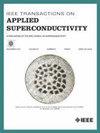Reducing Magnetization AC Loss in Twisted-Stacked HTS Cables
IF 1.7
3区 物理与天体物理
Q3 ENGINEERING, ELECTRICAL & ELECTRONIC
引用次数: 0
Abstract
Due to the high critical current density and isotropic properties of stacked-tape high-temperature superconducting (HTS) conductors, they become potential candidates for fusion magnets. However, when used in fusion magnets, significant magnetization ac loss can generate heat, burden the cooling system, and even lead to quench. Therefore, evaluating and optimizing the magnetization ac loss of twisted stacked-tape cables (TSTCs) is crucial. The total magnetization ac loss of twisted stacked HTS cables was measured using the nitrogen boil-off method with various frame materials and twisting angles subjected to an alternating magnetic field, thereby optimizing the structure of TSTCs to reduce magnetization ac loss. In addition, twisted stacked-tape cables were simulated using a 3D T-A equation, whose results were compared with the measurements. This article comprehensively explained the effect of the twisting angle in magnetization ac loss, and proposed a new structure of the twisted stacked-tape conductor to further reduce magnetization ac loss. The novel structure design and optimization methods can be beneficial for designing future HTS conductors for fusion magnets.降低高温超导绞合堆叠电缆的磁化交流损耗
由于叠层带高温超导(HTS)导体具有较高的临界电流密度和各向同性的特性,使其成为聚变磁体的潜在候选材料。然而,当用于熔合磁体时,显著的磁化损耗会产生热量,给冷却系统带来负担,甚至导致淬火。因此,评估和优化扭曲叠带电缆(TSTCs)的磁化交流损耗至关重要。采用氮蒸发法测量了在交变磁场作用下,不同框架材料和不同扭转角度下,扭曲堆叠高温超导电缆的总磁化交流损耗,从而优化TSTCs的结构,降低磁化交流损耗。此外,使用三维T-A方程模拟了扭曲的堆叠带电缆,并将其结果与测量结果进行了比较。本文全面阐述了扭转角对磁化交流损耗的影响,提出了一种新的扭曲叠带导体结构,以进一步降低磁化交流损耗。这种新颖的结构设计和优化方法对未来用于核聚变磁体的高温超导导体的设计具有指导意义。
本文章由计算机程序翻译,如有差异,请以英文原文为准。
求助全文
约1分钟内获得全文
求助全文
来源期刊

IEEE Transactions on Applied Superconductivity
工程技术-工程:电子与电气
CiteScore
3.50
自引率
33.30%
发文量
650
审稿时长
2.3 months
期刊介绍:
IEEE Transactions on Applied Superconductivity (TAS) contains articles on the applications of superconductivity and other relevant technology. Electronic applications include analog and digital circuits employing thin films and active devices such as Josephson junctions. Large scale applications include magnets for power applications such as motors and generators, for magnetic resonance, for accelerators, and cable applications such as power transmission.
 求助内容:
求助内容: 应助结果提醒方式:
应助结果提醒方式:


